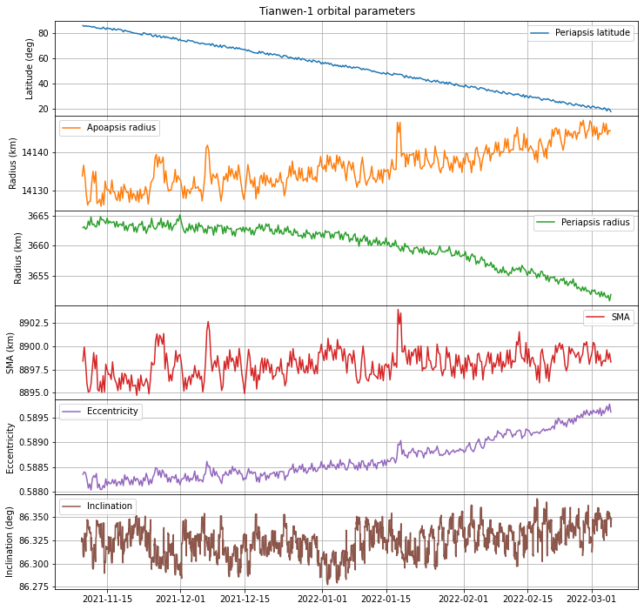Tianwen-1, the Chinese Mars orbiter, entered its remote sensing orbit on November 8 2021. In a previous post, I gave an overview of the orbit using one month of state vector data collected from the spacecraft’s telemetry by AMSAT-DL using the 20 m antenna at Bochum observatory. AMSAT-DL has continued receiving telemetry almost every day, so in this post we can now look at nearly 4 months of data for the remote sensing orbit.
This orbit is a polar elliptical orbit with 86 deg inclination, a periapsis altitude of 275 km and an apoapsis radius of 14140 km. The orbital period is approximately 2/7 Mars sidereal days plus 170 seconds. This makes the ground track drift slowly towards the west, allowing the spacecraft to scan all the planet’s surface. Additionally, due to orbit perturbations, the argument of periapsis (and hence its latitude) keeps slowly changing with time. This makes possible to scan all of Mars from a low altitude.
The orbit trajectory is studied in the same way as in the previous posts about this topic. GMAT is used to propagated the telemetry state vector data during the gaps with no data, so as to obtain a continuous trajectory.
The figure below shows the orbital parameters’ evolution over the course of the last 4 months. The data regarding the periapsis and apoapsis (radius and latitude) is obtained from each of the periapsis/apoapsis passages, rather than using the osculating orbit Keplerian elements for each timestamp. The reason is that during each revolution, the osculating orbit Keplerian parameters vary significantly due to perturbations, so their plots would be noisier. The semi-major axis (SMA) and eccentricity are measured from consecutive periapsis and apoapsis passages. The inclination is measured from the osculating orbit for all the timestamps, however.

We can see that the periapsis latitude has kept steadily decreasing. The rate at which it changes is 0.593 deg/day. This means that in about 304 days, the periapsis will have moved 180 degrees, and thus have covered all the latitudes from the north to the south pole.
There has been a small change in eccentricity, with the corresponding changes in the periapsis and apoapsis radiuses. The change is very small, however, and perhaps it follows a sinusoid (though it is soon to tell, just by looking at this data). The semi-major axis has stayed almost constant, although perhaps it has increased by a couple km. The inclination hasn’t changed at all.
The next figure, which already appeared in the previous post shows how the longitude of the equator crossings (orbit nodes) changes over time. Ascending nodes are shown as an upwards pointing triangle, and descending nodes are shown as a downwards pointing triangle. The ground track almost repeats every 7 revolutions, so a cycle of 7 colours is used to identify the revolutions. In this way, nodes that happen at nearly the same longitude after ~2 Mars sidereal days get the same colour.

We can see how the orbit drifts west due to the extra 170 seconds in the period. Also, we can see that there are pairs of ascending and descending nodes that occur at similar longitudes, so the plots looks like 7 bands moving diagonally. More precisely, if we look at the moment when the spacecraft passes a descending node and advance “1.5 revolutions”, we see the spacecraft at an ascending node at almost the same longitude.
The reason for this is that the time spent between each consecutive pair of nodes is not equal, because the orbit is elliptical. Since the periapsis is on the northern hemisphere, the time it takes to move from an ascending node to the next descending node is much less than the time it takes to move from a descending node to the next ascending node. If the orbit was circular, then 1.5 revolutions would take 3/7 ≈ 0.429 Mars sidereal days. The spacecraft would be on the opposite point of its orbit, and Mars would have rotated by 0.429 revolutions, so the spacecraft’s longitude would be somewhat east from where it started.
However, since the orbit is elliptical, performing “1.5 revolutions” to go from a descending node to an ascending node takes more than 3/7 sidereal days. This is the reason I am writing “1.5 revolutions” in quotes. In fact, when the periapsis was near the north pole, this took a bit over 0.5 sidereal days, so we find the spacecraft slightly to the west of where we started.
However, as the periapsis moves closer to the equator, this asymmetry starts to reduce, until it takes the same time to move from the ascending node to the descending node as vice versa (which will happen when the periapsis is over the equator). This is the reason why if we look at the pairs of ascending and descending nodes that have similar longitudes, their relative positions change with time. Around February 7 their longitudes coincide, and after that they “cross over”. This pattern will keep changing in the same way as the periapsis moves into the southern hemisphere.
The plots in this post have been done in this Jupyter notebook.
2 comments